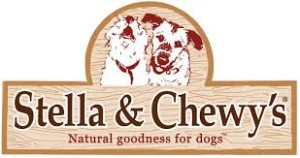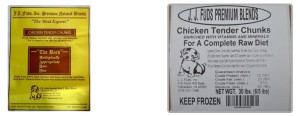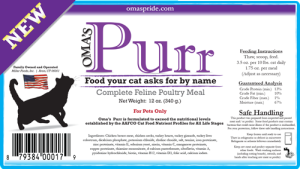Ashley Chaifetz, a PhD student studying public policy at UNC-Chapel Hill writes:
Feeding a raw diet to your pet? And through a dog food co-op? This might sound like an awesome idea, but it is not the safest plan.
Sheila Pell at Modern Farmer writes,
Offer a dog a piece of kibble in one hand and a morsel of meat in the other. It’s that obvious choice that moves many pet parents to join a dog food co-op, and share the task of procuring fresh meats, fruits and vegetables to be shared among their pet’s food bowls. Not everyone can find one nearby, but more are cropping up all the time.
While feeding raw food might be preferable to the dog, taste-wise, a pet doesn’t know which foods might be contaminated with Salmonella, E. coli or other pathogens. Domesticated animals rely on humans to make the best choices possible for their meals.
Yet, that might not always happen.
Proponents also argue that dogs evolved to eat primarily raw foods, mainly meat and bones, not starchy overcooked grains. The benefits of approximating that diet, many say, include healthier skin and coats, cleaner teeth, more energy and less poop.
Pell notes that there are dissidents,
Many veterinarians, and the FDA, discourage raw feeding due to threats from bacteria. Studies in veterinary journals have documented the risks. Some long-time raw feeders point out that bacteria (salmonella, for one) is also a problem in commercial pet food. Other risks are feeding an unbalanced diet and the potential for whole bones to cause choking, break teeth or puncture an organ.
My dog would regularly eat poop for dinner if it were up to her. Commercial dry food has had contamination issues the risk is increased when the meal is raw. Veterinarians have suggested that raw chicken can have too much phosphorous or calcium—and consuming bones, among other items, can easily get stuck in an animal’s esophagus and lead to other health issues (Thompson et al., 2012). But it’s safety that got the pet owners interested in this diet in the first place.
But pet food recalls and the local/organic food trend got pet owners interested in providing their dogs with a higher quality feed. By shortening the farm-to-bowl chain, many owners feel they can rule out many of the toxic traces of industrial food production.
Just shortening the supply chain is not the mythical answer to lessening a supposed toxic industrial food system. A nearby processor of raw food can be just as risky as a far-away processor of conventional kibble. And while dog food co-ops might use best practices, it is not a guarantee that every purveyor does as such.
I look up product contents, company histories, and prevalence of recalls, as well as how any recall was handled, before feeding my dog a new brand of food. Before joining a cooperative, I would research its processing practices, transport procedures, and operating procedures –for the health of my dog and me, since I can get sick from contaminated dog food: dry, wet, or raw.
 The Consumer Council said it found salmonella in three of 17 samples during random tests on pet food.
The Consumer Council said it found salmonella in three of 17 samples during random tests on pet food.









